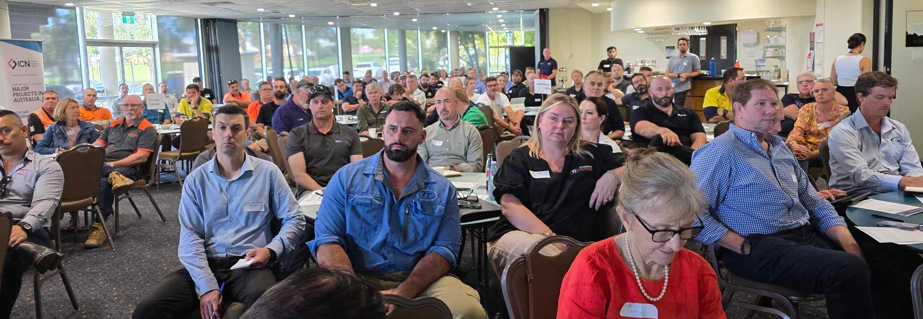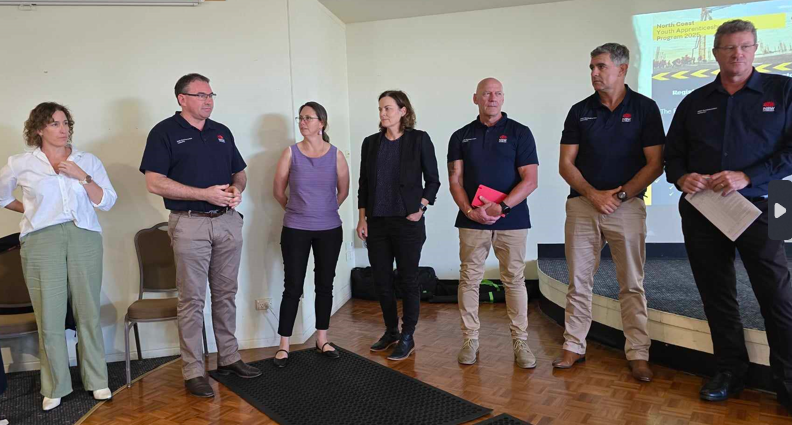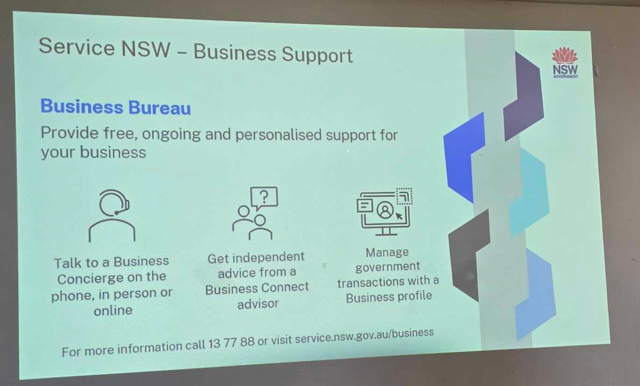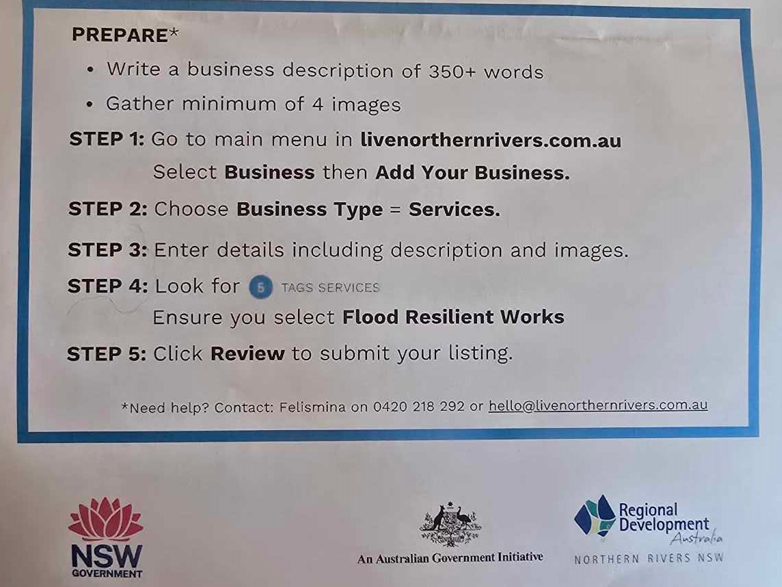2025 The Year of Construction - over 200 turn up for RA meeting
Lara Leahy
31 October 2024, 8:01 PM
 MP Janelle Saffin and organiser of the RA Construction Industry Event, Katrina Luckie, pleased with the turnout.
MP Janelle Saffin and organiser of the RA Construction Industry Event, Katrina Luckie, pleased with the turnout.On Wednesday night, the construction industry answered the call from the NSW Reconstruction Authority (NSWRA) to get a deeper understanding of where we are in the rebuilding process and upcoming opportunities.
The group discussed what they have done so far and the rest of the iceberg, the part that is to come in 2025 - the year of construction… and beyond.
The planning and processing for much of the work has been started or done, and the physical aspect of what needs to be undertaken in our recovery has only just begun.
NSW Parliamentary Secretary for Disaster Recovery and Lismore MP Janelle Saffin gave perspective to the tasks ahead; “We've turned the corner. There's still some people who remain with challenges, and there are business challenges, because we've got the cost of living, plus the big event of 2022, so I'm not trying to minimise that, but we're turning a corner, and there are good things happening in the recovery.
“This money we talked about, the billions that is coming into our economy, will really help. The programs are now just starting to come to fruition, so that's a good thing. Money will start to flow more.
“More money, more jobs, more money spent locally. It's a good thing.”
The main topics of discussion were the $790 million dollar Resilient Homes program, the $2.86 billion on infrastructure works and councils extensive $4 billion dollars BAU (Business as usual) works currently planned. Also mentioned were the $100 million Resilient Land Program.
Kristie Clarke, NSWRA’s executive director of the Northern Rivers Adaptation Division, relayed the latest buyback figures, “Just over 1000 homeowners have been in contact, progressing the purchase of their homes.”
All of those homes need something done to them, whether it be relocation or recycling.

(There was a large turnout for the information session)
“The resilient measures program kicked off at the start of the year.”
Resilient measures include raising houses ($100,000) and retrofits ($50,000). The process of getting those works underway is beginning.
“That $50,000 and $100,000 lots of work opportunity for particularly local builders and local industry within those programs.”
There is a sharp focus to not waste anything that can be salvaged or redistributed.
“We're reusing and recycling the housing stock that we have, and we're working with other government agencies, such as Homes New South Wales and the Aboriginal Housing organisation.
“We hope to find opportunities for us to be able to partner with them for the re-establishment of these homes in the region.”
Houses that are structurally unsound need to be removed, “We have already achieved a really high proportion of recycling of that housing stock, which is excellent - 75%, but we are aiming for 80% from here on in.”
Kristie acknowledges, “Sometimes dealing with government bureaucracy and procurement process, can be complicated. What we want to do is be able to try and provide you details of the full pipeline of work so that you can consider opportunities that your business may be interested in and have further discussions with our team.”
That last point is important. There were people who were in the audience that brought up pain points in the process. In any system that is bound to happen, but the RA wants to know how they can do things in a better manner.
The work is there and needs to be completed, however, Kristie is firm on the high quality of work that is needed for the success of the program.
Graham Kennett, Executive Director of Reconstruction, spoke about Infrastructure, “There's almost $3 billion worth of recovery work to be done across the region. The bulk of that, almost 2 billion in the road and bridges category, over 100 million in water and wastewater, another $700 million in buildings and a couple of hundred million of other infrastructure recovery works.”
“That's in addition to $4 billion worth of BAU, work that councils and the agencies will be trying to get done concurrently to all of this recovery work.”
The point being made was about how much work there is. The next step was HOW to find it.
“There's one piece of work, in particular, that I would encourage you all to get onto quickly - the LiveNorthernRivers website (all links below).
“The RA has put together, in one website, a central reference point for all of the various Council tenders. So all of the councils have their individual methods - they might use an e-tender or tender link or a portal of their own that you might have to register on.
“At LiveNorthernRivers all of those current tenders are brought together, and past tenders for you to have a look at, and then you can go from there to those individual Council websites and get yourself registered on theirs.”
Graham explains that there will sometimes be a primary or head contractor that will take charge of a large project and adds, “Just about everybody that's a head contractor on one of those tenders is going to rely on their subcontractors to get the job done.
“There's a need for those partnerships to be established, to be ready with your rates and your prerequisites for working on those particular sites and through those agencies.”
Only 10% of the $2.86 billion infrastructure works have been completed to date.
11% of contracts will be large - over $5 million.
“There's a lot of opportunity for smaller scale, lower risk project opportunities. The bulk of the work, 36% is in the less than $100,000 at a time.
“We are at a pretty pivotal point at the moment, where all of the processes in the background, the bureaucratic processes around funding and security of grants for the councils to get on with their work are really only just starting to finish off.”
57% of projects are in the initiated or planning phase.
“They've been scoped, funded, and the councils are now looking at how to program that over the next couple of years for their delivery, and they'll have a design work procurement processes to go through, and there's a lot of opportunity along the way.”
The works discussed are across the 7 LGAs in the Northern Rivers, but there is one larger project in Lismore - the East Lismore Wastewater Treatment Plant.
“It's not a small project; it's something in the order of $45 million on its own. And again, there'll be a large head contract needed there, but a lot of subcontract work that'll be needed to pull that project off.”
There was a who's who of RA personnel in attendance to meet and connect with the various areas of work required.

(Laura Robinson, Acting Manager of Industry and Economic Recovery, Catherine Gates, Senior Policy Officer (home relocations), Jane Holden, Senior Programmer (Resilient Homes Program), Jeff Waterhouse, Program Director and RRRP Programmer, Gary Randall, Director of Reconstruction Delivery and Graham Kennett, Executive Director)
John spoke for the works happening at Lismore City Council, “We've got five programs, Buildings, Flood resilience, which is around the pump stations, Mitigation measures around the levy, etc, Roads and bridges is the biggest package of work within the portfolio, and there’s waste and water.”
These five packages include 341 individual projects.
“Of the 341, 214 are currently in development. So we're looking at designs and developing the scopes of those projects.
“All these packages are going to require local support, small contractors, large contractors, a lot of design support. We'll let packages as design only, as D&C, and as construct only. So good to see everyone here, and there's plenty of work to come through.”
Services NSW were there with representatives talking about their Business Concierge service with the “aim to help small, medium and Aboriginal businesses located in the Northern Rivers region, in assessing tendering and procurement tools, resources and capability building opportunities to engage in the upcoming reconstruction pipeline of works.”
You can find them at 14 Carrington Street to discuss your business needs.

One final resource for businesses is how to find talent to join your teams.
“JobsNorthernRivers is a dedicated website for employment specific to the Northern Rivers region. It is free to post jobs on there to build a business profile and talent pools.”
There is a lot going on in the training and employment space, so we shall leave that for another story.
The NSWRA called the meeting for the construction industry - to hear about the current program of works and available opportunities. The response was so overwhelming, that they had to change to a larger venue and restrict the amount of people per organisation.
They plan to have more meetings to reach out to the industry in a similar way.
Ms Saffin was impressed with the response, “Over 200 people responded, and nearly that amount are here. So that says people want to belong. It's about economic opportunity, but emotionally, everybody wants to be part of it. And that was reflected here.”
Links to information discussed above:
Tendering website: LiveNorthernRivers.com.au

Jobs and Talent Pool website: JobsNorthernRivers.com.au
There are also opportunities to connect with the NSW Government as a supplier and services hub to register on, or look for project work at buy.nsw.gov.au.

